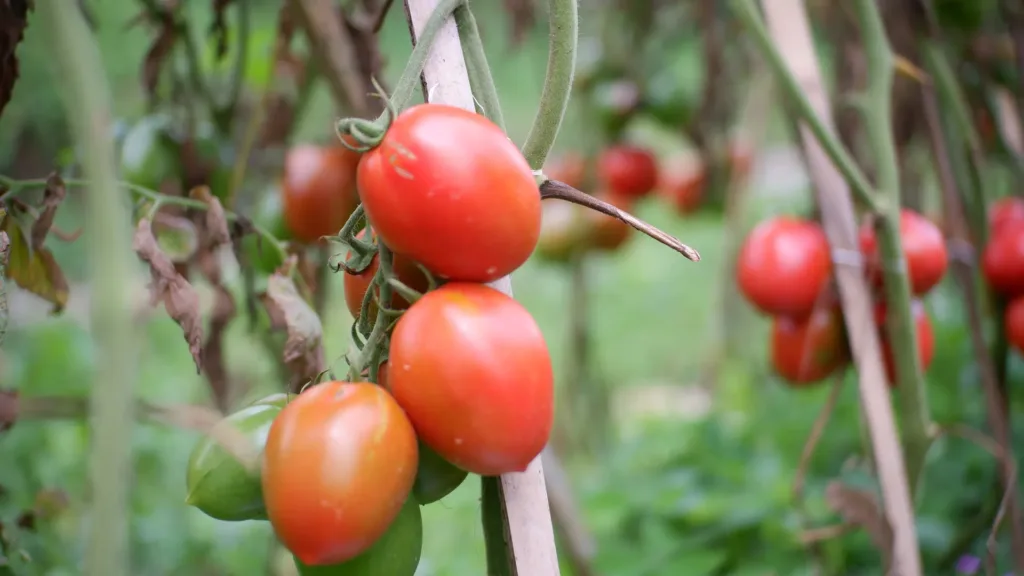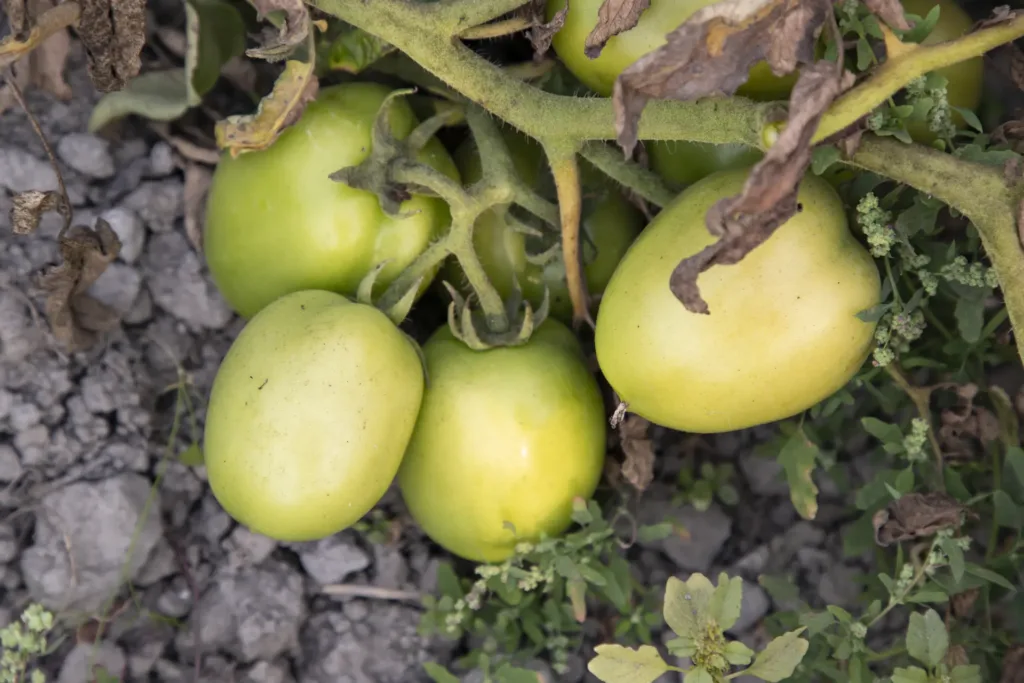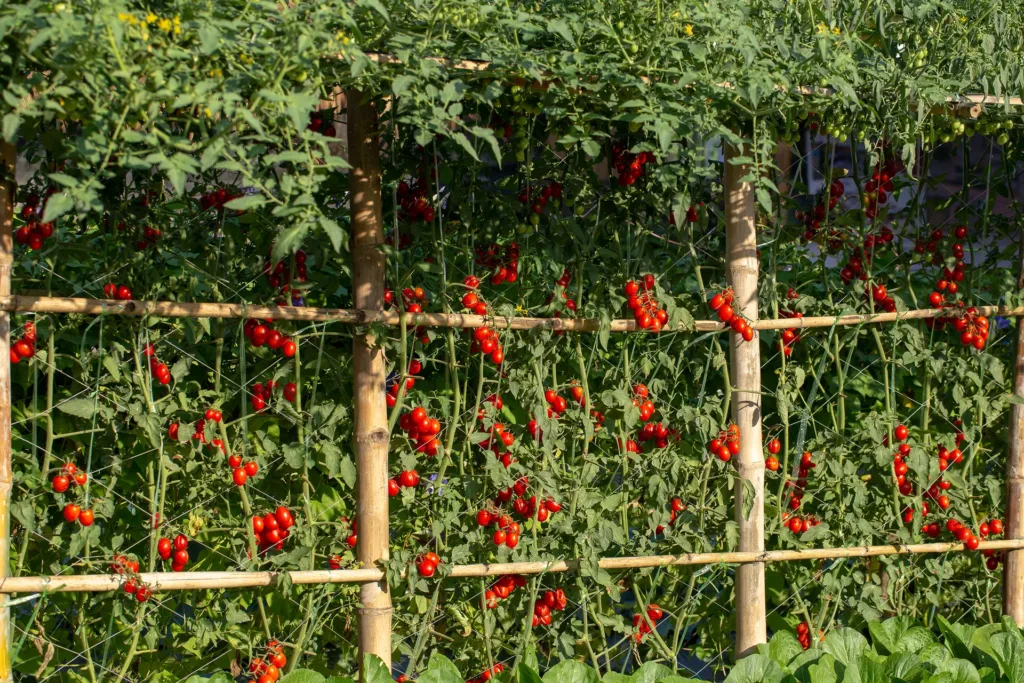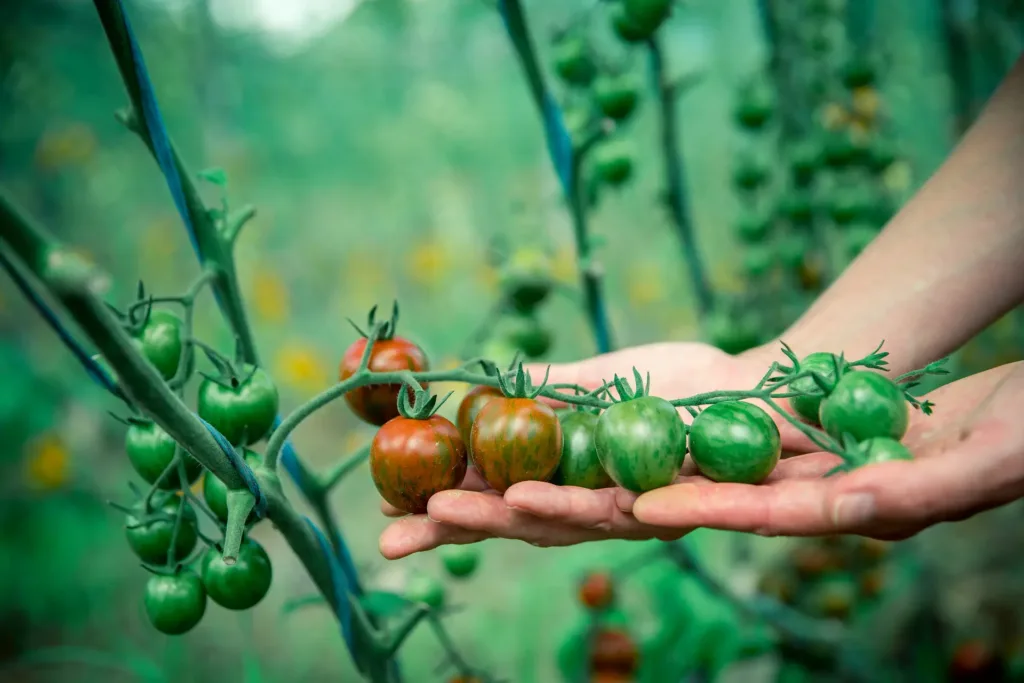Tree tomatoes, or tamarillos, are captivating both in gardens and cuisine. You’re in the right place if you’re curious about these vibrant fruits. This guide will walk you through the essentials of tree tomato care, from planting to harvest, helping you integrate them into your culinary adventures while enhancing your green space.
Table of Contents
Crucial Points
- Tree tomatoes (tamarillos) originated from the Andes, are part of the nightshade family, and can be grown for their attractive features and flavorful fruit.
- Tamarillos require six to eight hours of direct sunlight, well-drained soil enriched in organic matter, regular watering, and protection from strong winds for optimal growth.
- Proper care includes using high-quality potting soil, managing pests and diseases, annual pruning, and implementing companion planting to enhance the health and productivity of tamarillo trees.
Discovering the Tree Tomato: An Introduction
The tamarillo plant, lovingly referred to as the tree tomato, has a rich and intriguing backstory. Originating from the Andean highlands of South America, it was historically cultivated by the Incas. Known by various names including tomate de arbol, sachatomate, and tree tomato tamarillo, the tamarillo is a testament to the diversity of nature and the richness of ancient cultures.
Characterized by its oval to heart-shaped leaves, the tomato tree forms an umbrella-like crown, adding to its unique charm. Whether you’re looking to diversify your garden or seeking a new culinary venture, the tree tomato is a wonderful choice. Its rich red fruit is not only visually appealing but also packed with a flavor punch that can elevate any dish.
The Tamarillo Tree Explained

The tamarillo tree, botanically classified within the Solanum betaceum species, is part of the larger nightshade family, Solanaceae. As a fast-growing, woody small tree, it can reach impressive heights of two to five meters, depending on the variety. Its features include:
- Large, evergreen leaves, reaching lengths of up to 30-40 cm and widths of 20-35 cm
- Distinct musky smell
- Unique addition to any garden, both visually and aromatically.
One of the most striking features of the tamarillo tree is its fruit. This ovoid berry sports a fruit skin that can showcase a vibrant range of colors, including shades of yellow, orange, and red. Whether you’re planning to use them in your kitchen or simply enjoy their beauty in your garden, the colorful fruits of the tamarillo tree surely won’t disappoint.
Planting Your Own Tree Tomato

The process of planting your own tree tomato is an exciting journey. You can start by sowing tamarillo seeds in compost from April onwards, utilizing Organic Herb & Seedling Compost for healthier root growth. After sowing, maintaining a consistent level of soil moisture is paramount. Here are the steps to follow:
- Sow tamarillo seeds in compost from April onwards, using Organic Herb & Seedling Compost for healthier root growth.
- Cover the seed tray with a plastic cover.
- Keep the seed tray in a warm place above 20°C to encourage successful germination.
Within a couple of weeks, you’ll start to see seedlings emerging. You can then transplant these young tree tomato plants or seedlings outdoors after mid-May. This is the ideal time once they have been successfully grown from seed or purchased as starter plants.
Preparing the soil beforehand by enriching it with organic matter and ensuring well-drained conditions is key. Remember to use nutrient-rich soil like high-quality potting soil when potting, and keep the soil moist to promote healthy plant growth.
Ideal Conditions for Thriving Tamarillos
Understanding the optimal growing conditions is fundamental for your tamarillos to flourish. Tree tomatoes flourish when they receive around six to eight hours of direct sunlight daily. However, in hotter climates, they require partial shade to prevent overheating. Providing shade during the afternoon hours can offer respite from the intense heat.
In terms of climate, the ideal USDA Zones for cultivating tree tomatoes are 10–11, offering a suitable temperature range and climate conditions. Furthermore, due to their shallow root system, tamarillos require protection from strong winds. Regular watering to maintain moist soil is also important to prevent drought stress and maintain optimal growth.
Once these conditions are met, anticipate your tamarillo trees to prosper and yield an abundant harvest.
Plant Spacing and Depth
Plant spacing and depth are important factors to consider when planting tamarillos. Tamarillo plants should be spaced 1.2 to 1.5 meters apart in the Andean region. However, in New Zealand’s mechanized production systems, the recommended distance is 1 to 1.5 meters between plants and 4.5 to 5 meters between rows. These spacing variations are influenced by the production system used, with wider row spacing accommodating mechanization.
Appropriate plant spacing is vital for tamarillo trees to obtain sufficient air circulation and sunlight, both crucial for robust growth and fruit production. In addition, the planting depth should be sufficient for the root system to develop properly and stabilize the plant as it grows. By paying attention to these details, you can optimize your tamarillo trees’ growth conditions and set them up for a successful harvest.
Cultivating Tamarillo Trees for Optimal Growth

After planting your tamarillo trees, your next focus should be fostering their best possible growth. High-quality potting soil is crucial given their rapid growth and significant water requirements. Daily checks are recommended to ensure the tamarillo root ball is sufficiently moist while avoiding waterlogging.
While tamarillo trees often don’t require fertilizer in nutrient-rich soil, they can benefit from applying liquid fertilizer during their flowering or fruit production periods. If you’re growing tamarillo trees in containers, be aware they may need repotting due to their fast growth and should be overwintered indoors in cold climates. A wheeled container can be advantageous for easy relocation, especially when bringing plants indoors for winter care.
Managing Sunlight and Shade
Managing sunlight and shade is key to growing healthy tamarillos. They thrive best when they receive six to eight hours of direct sunlight every day. However, in hotter regions, providing partial shade during the afternoon can offer a respite from the intense heat.
Tree tomatoes benefit from the cooler temperatures that partial shade offers, especially during the peak heat hours. By managing the balance between sunlight and shade, you can ensure that your tamarillo trees stay healthy and productive throughout the growing season.
Soil and Water Needs
When it comes to soil and water needs, tamarillo trees require well-drained soil enriched with organic matter. Frequent watering is necessary, especially for trees grown indoors, as the soil in containers can dry out more quickly than soil in garden beds.
Watering tree tomato plants early in the morning is beneficial as it reduces water loss due to evaporation and helps maintain moist soil during the warmest part of the day. By ensuring that your tamarillo trees are getting the right amount of water and are planted in well-drained, nutrient-rich soil, you’re setting them up for a fruitful growth journey.
Pruning and Training Tamarillo Trees
Not only does pruning and training your tamarillo trees aid fruit production, but it also helps maintain a manageable, compact plant that’s easier to harvest. Pruning should aim to promote growth closer to the plant’s center and be performed annually before winter.
Proper pruning techniques include removing withered, weak, or damaged branches and trimming back excessively long branches by up to half, which stimulates the growth of fruit-bearing wood. The ideal time for this annual pruning is just before winter, supporting the tree’s natural growth cycle and preparing it for the following growing season.
Defending Against Pests and Diseases
Like all plants, tamarillo trees are susceptible to pests and diseases. They can be prone to infestation by pests such as:
- Hornworms
- Aphids
- Fruit flies
- Scale insects
- Mealybugs
- Diamondback moth caterpillars
- Whiteflies
These pests can lead to various plant health issues, so it’s important to keep a close eye on your trees.
Fungal diseases like blight and powdery mildew can also affect tamarillos, manifesting as concentric dark brown spots and white spores on the leaves and stems. Prevention and treatment methods include using neem oil, insecticidal soap, and manual removal of pests where applicable. Regular preventive practices against diseases, like keeping the foliage dry and watering early in the morning, can reduce the need for control measures.
Harvesting and Enjoying Your Tree Tomatoes

Reaping your tree tomatoes is a gratifying endeavor. The fruits are ready to harvest when they exhibit their variety-specific yellow or red color and have a slight give when gently pressed. It’s important to use a snapping motion that keeps the stem attached to the fruit when harvesting tamarillos to avoid damaging the skin.
After you’ve harvested your tamarillos, you can store them at room temperature until fully ripened; then, they can be refrigerated for as long as 10 weeks. Alternatively, you can also use the cold-water dipping process for extended storage. The skin of the tamarillo is typically removed before eating due to its bitter taste. The skin comes off easily after immersing the fruit in boiling water for 4 minutes, and the tangy flesh inside can be enjoyed with a sprinkle of sugar.
From Garden to Table
After harvesting your tamarillos, you can finally relish the edible fruit of your hard work, similar to enjoying a passion fruit. Tamarillos have a tangy, tart, and slightly sweet flavor, coupled with a juicy, somewhat pulpy texture, providing a complex and fruity taste profile.
To prepare tamarillos for culinary applications, such as salsas, sauces, or salads, slice an X on the blossom end, cover with boiling water to facilitate peeling the skin off smoothly, and cut the fruit in half lengthwise. Whether you’re adding a fresh twist to your salad or creating a tangy tamarillo chutney, the possibilities are endless.
Preserving the Harvest
With preservation, you can savor the unique flavor of your tamarillo harvest beyond its typical growing season. Tamarillo chutney is a delightful way to extend the enjoyment of the fruit. Spreads and jams are another way to savor tamarillos in various dishes.
Freezing tamarillo flesh ensures that the fruit can be enjoyed well beyond the harvest season. By trying out different preservation methods, you can broaden the culinary uses of tamarillos throughout the year and make the most of your harvest.
Varieties of Tree Tomatoes to Grow
When it comes to growing tree tomatoes, you have several varieties to choose from. Some popular tree tomato varieties in the U.S. include:
- ‘Oratia Red’: Esteemed for its deep red skin, dark red flesh near the seeds, and a bold flavor that is excellent for culinary use and garnishing.
- ‘Rothhamer’
- ‘Inca Gold’
- ‘Ecuadorian Orange’
Amber tamarillos, known for being the sweetest, have a golden skin with a reddish tint and are smaller and milder in taste compared to other varieties. Gold tamarillos strike a balance in sweetness, being sweeter than the reds but less so than the ambers, which makes them adaptable for different culinary applications. By choosing to grow a variety of tamarillos, you can enjoy a range of flavors and colors in your garden and kitchen.
Creating a Companion Planting Oasis
Your tamarillo trees can derive significant benefits from companion planting. By planting certain plants near your tamarillos, you can attract beneficial insects and pollinators, reduce pests, and improve overall plant health.
Plants that can play a pivotal role in creating a thriving ecosystem around your tamarillo trees include:
- Basil
- Borage
- Marigolds
- Alyssum
- Sunflowers
- Zinnias
- Oregano
- Nasturtiums
By carefully selecting and planting these companions, you can create a vibrant oasis that not only looks beautiful but also promotes the health and productivity of your tamarillo trees.
Summary
Growing your own tree tomatoes is a rewarding endeavor that not only enhances your garden but also brings a unique culinary delight to your table. From understanding the history and characteristics of the tree tomato to learning about planting, care, harvesting, and preservation, you now possess the knowledge to embark on this exciting journey. So why wait? Get your hands dirty, plant some tamarillo seeds, and before you know it, you’ll be enjoying the fruits of your labor in delightful dishes. Here’s to a fruitful gardening adventure!
Commonly Asked Queries
When is the best time to plant tamarillo seeds?
The best time to plant tamarillo seeds is from April onwards. Happy planting!
How much sunlight do tamarillo trees need?
Tamarillo trees need around six to eight hours of direct sunlight daily to thrive, but in hotter climates, they may require partial shade to prevent overheating.
How should I prune my tamarillo trees?
To prune your tamarillo trees, aim to encourage growth near the center, prune annually before winter, remove withered or damaged branches, and trim back overly long branches by up to half. Happy pruning!
What pests and diseases affect tamarillo trees?
Tamarillo trees can be affected by pests like hornworms, aphids, and fruit flies, as well as fungal diseases like blight and powdery mildew. Watch out for these issues and take proper measures to protect your trees.
How do I know when tamarillos are ready to harvest?
You’ll know tamarillos are ready to harvest when they turn yellow or red and feel slightly soft when gently pressed. Happy harvesting!
Health Benefits of Tree Tomatoes (Tamarillos)
Tamarillos, or tomatoes, offer several health benefits:
- Antioxidants: High in vitamins C and E, which may lower disease risk.
- Heart Health: Potassium-rich, supporting blood pressure control.
- Digestive Aid: Fiber content aids in digestive health.
- Immune Support: Vitamin C boosts the immune system.
- Vision: Contains beta-carotene for eye health.
- Weight Management: Low in calories, high in fiber.
- Skin: Nutrients in tamarillos may protect the skin and promote healing.
While tamarillos are nutritious, those with kidney issues or nightshade allergies should consume them cautiously.
Nutritional Comparison: Apple vs. Tomato (Tamarillo)
Regarding nutritional value, apples and tomatoes (tamarillos) are healthy fruit choices, each with their unique set of benefits. Here’s how they compare:
Apples
Apples are a popular fruit known for their convenience and sweet taste. They are a good source of dietary fiber, which aids in digestion and can help control blood sugar levels. Apples also contain Vitamin C, potassium, and various antioxidants, including quercetin, which is known for its anti-inflammatory properties.
A medium-sized apple (about 182 grams) typically contains:
- Calories: 95
- Carbohydrates: 25 g
- Dietary Fiber: 4 g
- Vitamin C: 14% of the Daily Value (DV)
- Potassium: 6% of the DV
Tomatoes (Tamarillos)
Tomatoes are less common but are a nutritional powerhouse. They have a higher concentration of certain vitamins and minerals compared to apples, particularly Vitamin A, Vitamin C, and Vitamin E. Tamarillos are also rich in antioxidants and have a lower calorie count, making them an excellent choice for those looking to manage their weight.







Leave a Comment